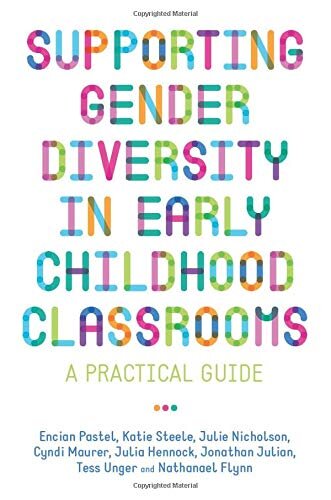Supporting Gender Diversity in Early Childhood Classrooms
A Practical Guide
By offering practical steps for adults who work with young children to build inclusive and intentional spaces where all children receive positive messages about their unique gender selves, this book increases awareness about gender diversity in learning environments such as child care centers, family child care homes and preschools.
The book is based on some of the most progressive, modern understandings of gender and intersectionality, as well as research on child development, gender health, trauma informed practices and the science of adult learning. By including the voices and lived experiences of gender-expansive children, transgender adults, early childhood educators and parents and family members of trans and gender-expansive children, it contextualizes what it means to rethink early learning programs with a commitment to gender justice and gender equality for all children.
ACKNOWLEDGEMENTS
This book was truly a team effort. Eight authors came together, first as thought partners, and then to translate these thoughts into a cohesive narrative, research ideas, conduct and code interviews, record anecdotes from our teaching experience, create graphics and illustrations to clarify complex ideas, find citations, create an index, and edit and review each other’s writing. For most of us, writing a book was an entirely new experience. Special thanks to Julie Nicholson for convincing us all that we could do it together, pulling pieces from each of us, and weaving them together into a coherent whole.
Beyond these eight authors, many others in our communities gave their time, effort, and stories to make this book come to life, and we’d like to acknowledge them here.
Ave-Ameenah Long, Helisa Katz, Ian Hoffman, Kate Engle, Kelly Lewis, Megan Madison, Mitali Purkayastha, Sophia Unger and Toby Kramer all shared stories from their lives as educators of young children and/or parents, as well as memories of social gender messages from their own childhoods. Five children under the aliases Chicken, Ivy, Max, Tink and Tobble shared illustrations and interpretations of what gender means to them. These interviews made the book vastly more concrete and readable.
Auden Smith, Julie Olsen-Edwards, Lilac Maldonado and Nori Reed read our manuscript and gave invaluable feedback, illuminating gaps, catching mistakes and helping us clarify ideas.
We hope that this book will inspire more group collaborations as it is read and reflected on!
Sincerely,
Encian on behalf of Gender Justice in Early Childhood
Radically Listening to Transgender Children
Creating Epistemic Justice through Critical Reflection
and Resistant Imaginations
This book is for early childhood educators committed to learning about gender [in]justice as a foundation for creating gender affirming early learning environments for all children including those who are transgender and gender expansive (TGE). The authors engage in progressive and contemporary thinking about gender acknowledging its complexity, intersectionality, diversity and dynamism. They draw on Miranda Fricker’s (2007) concepts of testimonial injustice to discuss how young TGE children are considered “too young” to have gender identities or to truly know themselves and hermeneutical injustice to represent the challenges TGE children face in educational environments that do not provide them with linguistic or interpretive tools to help them fully understand and communicate about their gender.
Woven throughout the book are the lived experiences and counter-stories of TGE children and adults that privilege their voices and highlight their right to contribute equally to societal understandings of gender and to access all the tools a given society has available at the time to help them name and understand their own experiences.The authors provide discourse, conceptual frameworks and concrete strategies educators can use to inspire resistant social imaginations (Medina, 2013) and actions that improve gender justice for our youngest children.



